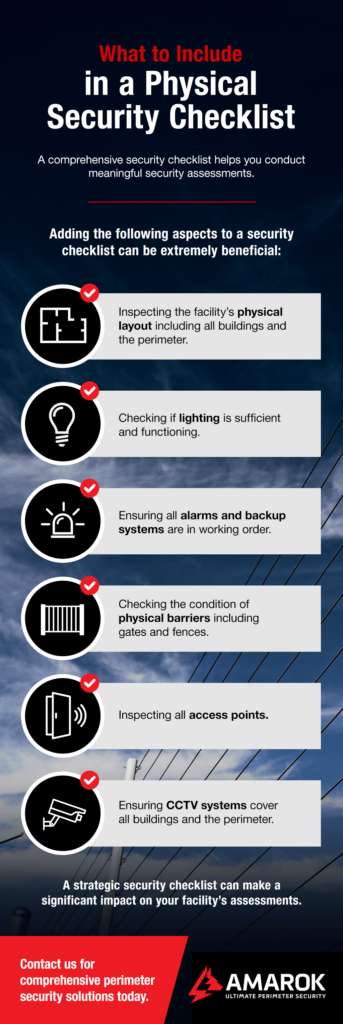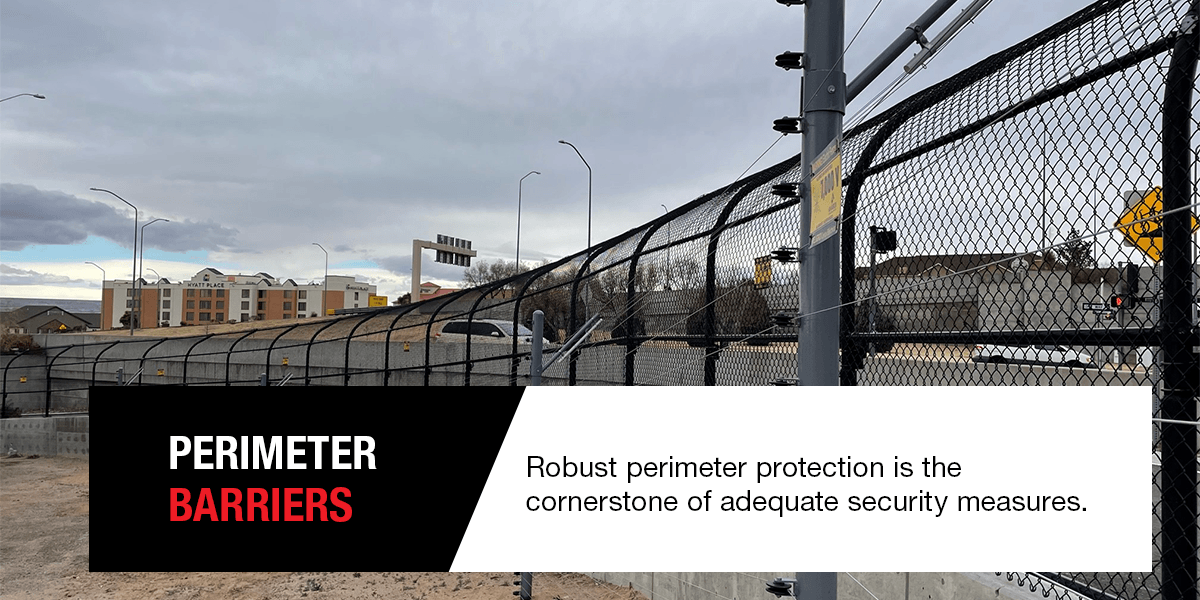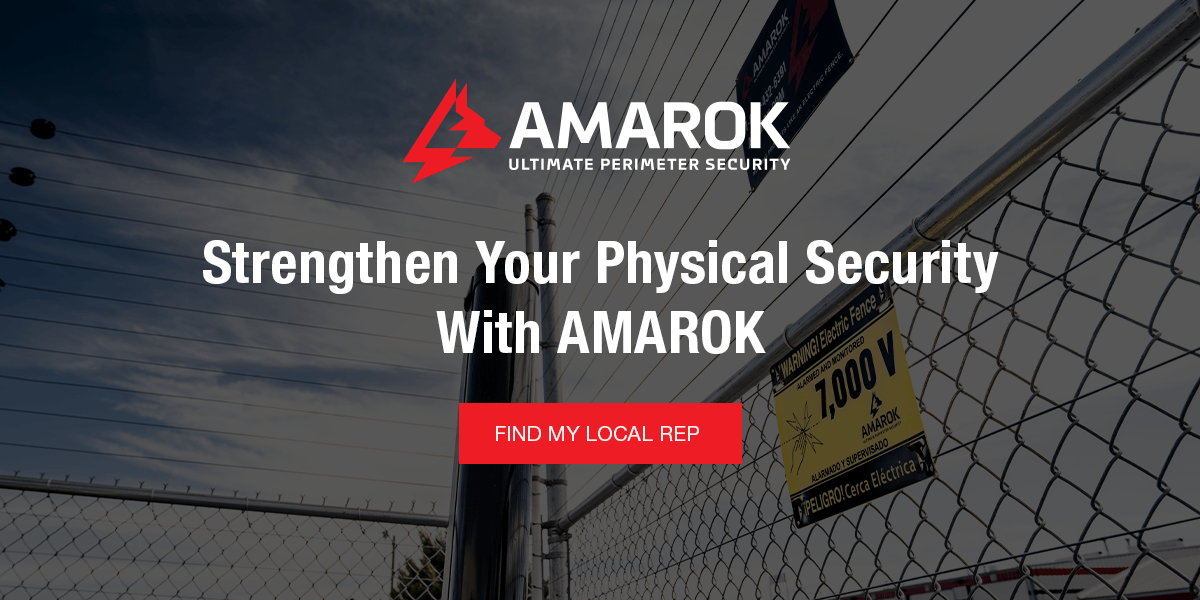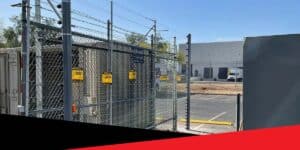Every day, businesses face increasing threats to their physical assets. According to the FBI’s Uniform Crime Reporting (UCR) Program, there were over 6.4 million property crime offenses in the United States in 2023 — resulting in the loss of goods worth $2.8 billion. Effective security is more critical than ever, and a thorough physical security checklist helps you identify vulnerabilities before criminals can exploit them.
9 Items to Account for on Your Physical Security Checklist

A physical security audit checklist is essential for identifying weaknesses and implementing practical solutions. Evaluate the following areas to identify any physical security vulnerabilities in your business:
1. Property Layout
Your property’s physical layout is the foundation of your security strategy. Examine how your site’s topography affects defensive capabilities. Identify potential vulnerabilities, such as hidden areas and blind spots. Natural elements like hills, valleys, and trees can create surveillance challenges, but also offer strategic advantages when properly incorporated into your security plan.
Pay attention to how your building’s placement on the property affects security. The distance between structures and property lines impacts response times. It also creates buffer zones against intrusion attempts.
You should also think about how adjacent properties might affect your security posture. Nearby vacant lots, wooded areas, or busy streets present unique security challenges. Natural barriers like water features, dense vegetation, or rough terrain can enhance your physical security when properly managed — but create vulnerabilities if left unchecked.
2. Perimeter Barriers
Robust perimeter protection is the cornerstone of adequate security measures. Evaluate the effectiveness of your perimeter barriers, including fencing, walls, and gates. Look for gaps, damage, or areas where intruders could easily scale or breach the barrier. Ensure your fences are at an imposing height and topped with barbed wire or other deterrents.
Traditional chain-link fencing does not adequately protect against criminals. Consider electric security fencing for perimeter protection, which uses pulsed electricity to deliver a safe but memorable shock to would-be intruders. In addition, anti-ram barriers protect vulnerable areas from vehicle-based attacks. Security cages and internal barriers create additional protection for high-value assets.

3. Access Points
Every entry point is a potential vulnerability. A comprehensive physical security checklist must address how people, vehicles, and materials move through these points. Assess all access points to your property and buildings, including doors, windows, loading docks, and roof access. Main gates require particular attention, as they handle the highest traffic volume and are targets for tailgating. Loading docks present unique challenges, requiring systems that maintain security while supporting efficient operations.
Consider automated access control systems, which can verify credentials, track movement patterns, and integrate with other security systems to provide comprehensive entry management. Your facilities should also feature reinforced doors and windows to protect against breach attempts.
4. Lighting Systems
Thoroughly assess your exterior and interior lighting. Identify poorly lit or shadowed areas that could provide cover for intruders. Implement constant illumination and motion-activated lighting to eliminate hiding spots, improving visibility.
Consider an alarm-based security lighting system for integrated protection and active deterrence. When triggered, these systems activate bright lights and loud sirens. In addition, they alert security personnel to potential threats.
5. Video Surveillance Infrastructure
Physical security requires sophisticated video surveillance as one layer of overall security measures. Ensure your camera systems provide comprehensive coverage while maintaining excellent image quality. Strategic placement ensures no blind spots and offers overlapping fields of view of critical areas.
Video surveillance infrastructure must address day and night conditions, with appropriate technologies for low-light operations. Your surveillance system should also:
- Include weather protection to ensure consistent operation in all conditions.
- Have backup power systems to maintain surveillance during outages.
- Integrate with other security measures to create a coordinated response to potential threats.
6. Alarms and Intrusion Detection
Assess your alarm systems and building intrusion detection devices. These include door and window sensors, motion detectors, and glass break sensors. Ensure your alarms are correctly configured, maintained, and monitored 24/7.
Integrate your alarm systems with video surveillance and access control systems for a more comprehensive security solution. These systems should distinguish between genuine threats and environmental factors. Adequate differentiation reduces false alarms and ensures actual incidents receive immediate attention.
7. Security Personnel and Asset Protection
If your business employs security guards, evaluate their effectiveness, training, and deployment strategies. Your guards should be adequately trained in emergency response and conflict resolution. Implement random or targeted patrols to deter potential intruders and respond quickly to incidents.
Identify and assess your high-value assets, such as cash, inventory, equipment, or sensitive data. Properly secure these assets in locked rooms, safes, or reinforced storage areas. It’s important to implement strict access controls and monitoring for these high-security zones. Specialized security personnel and increased guard patrols can provide added asset protection.
8. Emergency Response and Evacuation
Any security system requires effective response capabilities, including monitoring stations and communication systems. When integrated with your perimeter security and response solutions, these systems ensure adequate crisis response. Regularly review your emergency response systems and evacuation plans.
Mark all emergency exits, ensuring they are well-lit and unobstructed. Regular drills and training sessions are critical to familiarize employees with evacuation procedures and assembly points, ensuring their safety during an incident.
9. Compliance and Regulations
Depending on your industry and location, you may be subject to specific security regulations or standards. Review your compliance obligations and ensure your physical security measures align with these requirements. These regulations may include the ADA Standards for Accessible Design, American National Standards Institute (ANSI) building codes, and National Fire Protection Association (NFPA) codes.
Strengthen Your Physical Security With AMAROK
Conducting an exhaustive physical security audit using this checklist is an essential step in safeguarding your perimeter against external threats. As a leading provider of perimeter security solutions, AMAROK offers a comprehensive, multi-layer approach to securing your property, including The Electric Guard Dog™ Fence. With our fencing solutions, 99% of customers experience zero external theft.
AMAROK’s security-as-a-service model allows you to enjoy the benefits of cutting-edge security measures with the convenience of a manageable monthly fee — unlimited maintenance and repairs included.
Contact us today or find your local representative to learn more about our solutions. You can also give us a call at (803) 786-6333.






